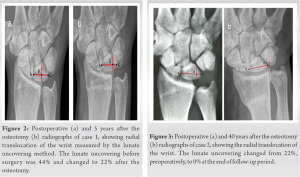Closed wedge osteotomy of the distal radius, is a technique that can be used for the treatment of advanced pseudoarthrosis of the scaphoid bone, and while union may be achieved the functional outcome is not dependent on it.
Dr. Konstantinos N Mastrantonakis, Department of Orthopedics, General Hospital of Rethymnon, Rethymnon 74100, Greece. E-mail: mastrantonakis.k@gmail.com
Introduction: Closed wedge osteotomy of the distal radius represents a treatment option for the advanced scaphoid pseudarthrosis. Few authors have reported good results with many of the cases achieving union of the scaphoid. The aim of this study is to inform about the functional long-term outcome of two patients in whom bone union was not achieved after this procedure.
Case Report: In this article, we present two patients, one with 5 and one with 40 years of follow-up who were treated with closed wedge osteotomy of the distal radius due to advanced scaphoid nonunion. We evaluated the functional outcome which was excellent and in addition radial translocation of the carpus was found as it was compared the anteroposterior radiographs before surgery and at the end of the follow-up period.
Conclusion: Closed wedge osteotomy of the radius is an extra articular procedure that can cause radial translocation of the wrist and change its biomechanics, while the functional outcome does not depend on whether fracture healing is achieved.
Keywords: Scaphoid nonunion, Scaphoid non-union advanced collapse wrist, radiocarpal arthritis, distal radius osteotomy, radial translocation.
Scaphoid pseudarthrosis leads to disturbance in wrist biomechanics, resulting in gradual development of arthritis, pain, reduced range of motion of the joint and a significant decrease in the functionality of the limb. Watson and Ballet in 1984 were the first to specify and classify the pathology seen after scapholunate ligament rupture, namely scapholunate advanced collapse (SLAC) wrist [1]. There is an expected sequence of arthritic changes that occur over time after the development of scaphoid non-union, which are similar to those after scapholunate ligament rupture [2]. Designation scaphoid nonunion advanced collapse (SNAC) wrist is more accurate and was first attributed by Krakauer et al. [3]. Degenerative changes start between radial styloid and distal scaphoid in the first stage. Ιn the second stage, the arthritic changes occupy the entire scaphoid fossa and the central part of the scaphoid, while in the third stage, arthritic lesions appear in the capitolunate joint. Degenerative changes rarely involve the radiolunate articulation and the proximal scaphoid. Scaphoid reunification surgeries, when arthritic lesions have occurred, have poor outcomes especially after advanced disease is developed. Multitude of techniques have been described for the treatment of the late SLAC stage. Dener vation, styloidectomy, different types of partial wrist arthrodesis, proximal row carpectomy and total wrist arthrodesis, as a salvage procedure; are some of them. Closed wedge osteotomy of the distal radius, as a method of treatment for late SLAC wrist, was firstly described by Giannikas and Papachristou in 1989 [4]. This method is not widely known, nevertheless results in pain reduction and restoration of wrist function. In several cases, that have been recorded, scaphoid union has been achieved [4, 5, 6]. In this study, we describe two patients with proximal pole scaphoid pseudarthrosis, who have been benefitted with closed wedge osteotomy. The purpose of this study is, not only to share the value of this extra articular technique, but also to timulate interest in appropriate study design and outcome measures. Interest in this topic will improve on technique and will determine specific indications of treatment.
Case 1
A 41-year-old male, with dominant right hand, was presented referring a disabling right hand pain with duration of 7 years. The patient had a history of a car accident 7 years ago, which led to multiple injuries and long-term hospitalization. This trauma in his hand, which was neglected, forced him to change profession from a construction worker to a cashier in a supermarket. Treatment, elsewhere, consisted of anti-inflammatory medication and short-term cast immobilization of the wrist. The physical examination demonstrated 50° flexion – extension of the wrist and reduced grip strength to 50% in comparison to his left hand. His Mayo Wrist Score was 50. Radiographs and computed tomography (CT) scan revealed scaphoid proximal pole nonunion with arthritic changes in radioscaphoid articulation and radial translocation of the capitate, which are findings of Stage II SLAC wrist. Management options were investigated, but due to the location of the pseudarthrosis, to the proximal scaphoid and the presence of arthritic changes, the attempt to reunite the scaphoid was ruled out. Two months after the initial diagnosis, a closed wedge osteotomy of the distal radius was scheduled which was performed by the first author. The osteotomy was made approximately 1.5 cm proximal to the radial styloid without cutting the medial cortex of the radius and the wedge opening was closed and stabilized with three Kirschner wire (K-wire). Afterward, the wrist was stabilized with a short arm cast for 1 month. Postoperatively, the patient was followed up in the outpatient clinic with dressing changes and radiographic control once a week. The K-wires and the cast were removed in the 4th week and gentle physiotherapy was recommended. The patient was followed up at 3, 6, 12, 24, and 60 months, with plain radiographs, measurement of grip strength and wrist motion in comparison with normal side. Wrist function was categorized according to Mayo Wrist Score. The 4th month after surgery, the patient changed his profession from supermarket cashier to construction worker. At 6 months the Mayo Wrist Score was found 90, which remained until the end of follow-up (Fig. 1c and d).
Case 2
A 72-year-old male presented for evaluation after a closed wedge osteotomy of his right hand, which was performed by our fifth author 40 years ago. The patient had experienced trauma, resulting in proximal pole fracture of the scaphoid bone. The fracture initially was treated conservatively which led to pseudarthrosis, pain, and disability of the right wrist. According to history, he had moderate pain, range of motion was limited to <50%, grip strength was <50% of normal and he was unable to work because of pain. The Mayo Wrist Score before surgery was 25. Ten years after the initial trauma, the patient underwent surgical treatment with closed wedge osteotomy of his right distal radius. In the follow-up period, according to him, he had a limitation in his work, who was a painter, for about a year and then he fully returned. In the present examination, the patient has a small limitation in range of motion, with no limitation in grip strength, he is pain free and he states that he experienced 40 years of unrestricted manual work. His functional capability, which was measured with the Mayo Wrist Score, was found 90 (Fig. 1a and b).
Radiographic follow-up
On last radiographic control, a proximal pole pseudarthrosis is present, with moderate arthritic changes of the carpus and no changes to radiolunate articulation. Comparing the pre-operative radiograph to the one taken 40 years after the operation, we observed radial translocation of the wrist. The lunate uncovering was changed from 22% to 0% after the osteotomy (Fig. 3).
Scaphoid non-union leads to wrist degenerative arthritis that causes pain and dysfunction to the affected hand. The expected sequence of arthritic lesions begin from narrowing of the distal radioscaphoid articulation. The incongruence between distal scaphoid fragment and radial styloid is a result of radial translocation of the capitate bone that leads to midcarpal arthritis. In advanced disease, extensive arthritis of the wrist is observed, with the radiolunate articulation being occupied last. Watson and Ballet in their seminal study suggested an operation by shifting the load of the wrist to the lunate fossa, after noticing that the radiolunate joint is almost never involved in degenerative changes. For that reason, they proposed limited arthrodesis to the wrist with replacement of the scaphoid with a siliastic implant. Surgical treatment is recommended even to asymptomatic cases because of progression of the arthritic changes [8]. However, there is no evidence on functional long-term outcome in patients who have not been operated. There are several surgical options when late SNAC wrist has already developed, distinguishing four corner fusion, capitolunate fusion, and proximal row carpectomy. Four corner fusion is the most preferred method with several studies analyzing long-term functional outcomes. Traverso et al. reported stable functional outcome, with most of the cases 73%, developing moderate arthritic changes and the rest of the cases severe arthritis [9]. In their study, they retrospectively evaluated a 2.5% from a total of 470 patients with an average follow-up of 18 years. Cha et al. retrospectively reviewed 40 patients who underwent four corner arthrodesis with a mean follow-up period of 12, 2 years. They found satisfactory functional outcomes at 5 years (83.2), while in 10-year follow-up, there was no significant difference evaluated by the Mayo Wrist Score and they observed minimal arthritic changes in the radiolunate articulation [10]. Neubrech et al. also found radiolunate arthritic changes with good functional outcomes. In a retrospective study, they evaluated a total of 60 wrists that underwent four corner fusion and they found 67% of the study population with advanced arthritic changes at a mean follow-up of 14.7 years [11]. Proximal row carpectomy is a well-established treatment option for radiocarpal wrist arthritis. A retrospective study evaluated long-term outcome (19.8 years on average) with 81 patients and showed poor long-term patient satisfaction. Only 27 patients in this study had recent radiographic control and almost half of the patients underwent this procedure for SNAC and SLAC wrist [12]. Other studies report that arthritic changes develop in the lunate fossa 10–12 years after PRC [13, 14]. Lunocapitate arthrodesis with scaphoid excision can be an equivalent of four corner fusion in terms of functional and radiological outcome as described by Ferreres et al. [15]. When properly executed, it has the advantage of preserving ulnocarpal proprioceptive function. In the above study, an average Mayo score of 68 was found, with only three poor functional results and only two patients developing arthritic changes out of 17 in a mean follow-up period of 10 years. Closed wedge osteotomy, as described by Giannikas and Papachristou in their seminal study, represents an extra articular technique which decreases the radial inclination and has the effect of reducing the pressure in the radioscaphoid articulation [4]. The same authors, in 2004, presented long-term results from patients receiving closed wedge osteotomy for the treatment of painful scaphoid pseudarthrosis [6]. In their study, they developed a scaphoid pseudarthrosis scoring system and they evaluated 77 patients, with a mean follow-up of 4 years. They reported that 86% of the patients were pain free, or with mild pain after heavy work on the last follow-up and all patients except two returned to their previous occupational activities. Although, there is no explanation on how 64% of the patients resulted in scaphoid union after osteotomy, in a such short period of immobilization, Monreal also reported bone union in five cases out of six with scaphoid pseudarthrosis without arthritic changes, that were treated with the same procedure [5]. In the most recent study, Malizos et al. combined osteotomy with scaphoid grafting, achieving scaphoid union in all 12 patients, suggesting that osteotomy may have affected bone union as a complementary therapy [16]. Despite the fact that in our cases, no union was observed at the end of follow-up, the functional long-term score was excellent, raising the question of how an extra-articular surgery can affect wrist function. Comparing the pre-operative and post-operative anteroposterior radiographs in both patients, we found radial translocation of the wrist measured by the Lunate uncovering method. The uncovered lunate represents the percentage of the lunate that remains uncovered by the articular surface of the radius [7]. This wrist displacement could be explained by two changes performed with the osteotomy. First, the decrease of the radial inclination could have caused less ulnar slipping and reduction of radioscaphoid pressure. Second, the transposition of the insertion of the volar radiolunotriquetral and dorsal radiotriquetral ligaments, (which ligaments protrude peripherally from the osteotomy) more proximal may have caused the transposition of the carpus radially.
Closed wedge osteotomy of the radius is a technique that seems to affect wrist biomechanics by radial translocation of the carpal bones. Although the technique has been described in the past in larger series than ours, this article refers for the 1st time the measurement of radial translocation with the lunate uncovering method. This change results in reduction of the pressure in radioscaphoid articulation, pain relief, and increase of wrist function.
Closed wedge osteotomy of the distal radius provokes translocation of the wrist radially. This change in the biomechanics of the wrist seems to have a beneficial effect on advanced scaphoid nonunion.
References
- 1.Watson HK, Ballet FL. The SLAC wrist: Scapholunate advanced collapse pattern of degenerative arthritis. J Hand Surg Am 1984;9:358-65. [Google Scholar]
- 2.Vender MI, Watson HK, Wiener BD, Black DM. Degenerative change in symptomatic scaphoid nonunion. J Hand Surg Am 1987;12:514-9. [Google Scholar]
- 3.Krakauer JD, Bishop AT, Cooney WP. Surgical treatment of scapholunate advanced collapse. J Hand Surg Am 1994;19:751-9. [Google Scholar]
- 4.Giannikas AC, Papachristou G. Wedge osteotomy of the lower end of the radius in the treatment of painful pseudarthrosis of the carpal scaphoid bone. Clin Orthop Relat Res 1989;246:16-21. [Google Scholar]
- 5.Monreal R. Treatment of scaphoid nonunions with closed-wedge osteotomy of the distal radius: Report of six cases. Hand (N Y) 2008;3:91-5. [Google Scholar]
- 6.Papachristou G, Giannikas A, Liodakis C. Management of painful pseudarthrosis of the carpal scaphoid bone with closed wedge osteotomy of the distal radius: A prospective study with long-term follow-up. Rev Chir Orthop Reparatrice Appar Mot 2004;90:714-21. French. [Google Scholar]
- 7.Wollstein R, Wei C, Bilonick RA, Gilula LA. The radiographic measurement of ulnar translation. J Hand Surg Eur Vol 2009;34:384-7. [Google Scholar]
- 8.Lindström G, Nyström A. Natural history of s c aphoid non-union, with special reference to “asymptomatic” cases. J Hand Surg Br 1992;17:697-700. [Google Scholar]
- 9.Traverso P, Wong A, Wollstein R, Carlson L, Ashmead D, Watson HK. Ten-year minimum follow-up of 4-Corner fusion for SLAC and SNAC wrist. Hand (N Y) 2017;12:568-72. [Google Scholar]
- 10.Cha SM, Shin HD, Kim KC. Clinical and radiological outcomes of scaphoidectomy and 4-corner fusion in scapholunate advanced collapse at 5 and 10 years. Ann Plast Surg 2013;71:166-9. [Google Scholar]
- 11.Neubrech F, Mühldorfer-Fodor M, Pillukat T, van Schoonhoven J, Prommersberger KJ. Long-term results after midcarpal arthrodesis. J Wrist Surg 2012;1:123-8. [Google Scholar]
- 12.Ali MH, Rizzo M, Shin AY, Moran SL. Long-term outcomes of proximal row carpectomy: A minimum of 15-year follow-up. Hand (N Y) 2012;7:72-8. [Google Scholar]
- 13.DiDonna ML, Kiefhaber TR, Stern PJ. Proximal row carpectomy: study with a minimum of ten years of follow-up. J Bone Joint Surg Am 2004;86:2359-65. [Google Scholar]
- 14.Jebson PJ, Hayes EP, Engber WD. Proximal row carpectomy: A minimum 10-year follow-up study. J Hand Surg Am 2003;28:561-9. [Google Scholar]
- 15.Ferreres A, Garcia-Elias M, Plaza R. Long-term results of lunocapitate arthrodesis with scaphoid excision for SLAC and SNAC wrists. J Hand Surg Eur Vol 2009;34:603-8. [Google Scholar]
- 16.Malizos KN, Koutalos A, Papatheodorou L, Varitimidis S, Kontogeorgakos V, Dailiana Z. Vascularized bone grafting and distal radius osteotomy for scaphoid nonunion advanced collapse. J Hand Surg Am 2014;39:872- 9. [Google Scholar]













